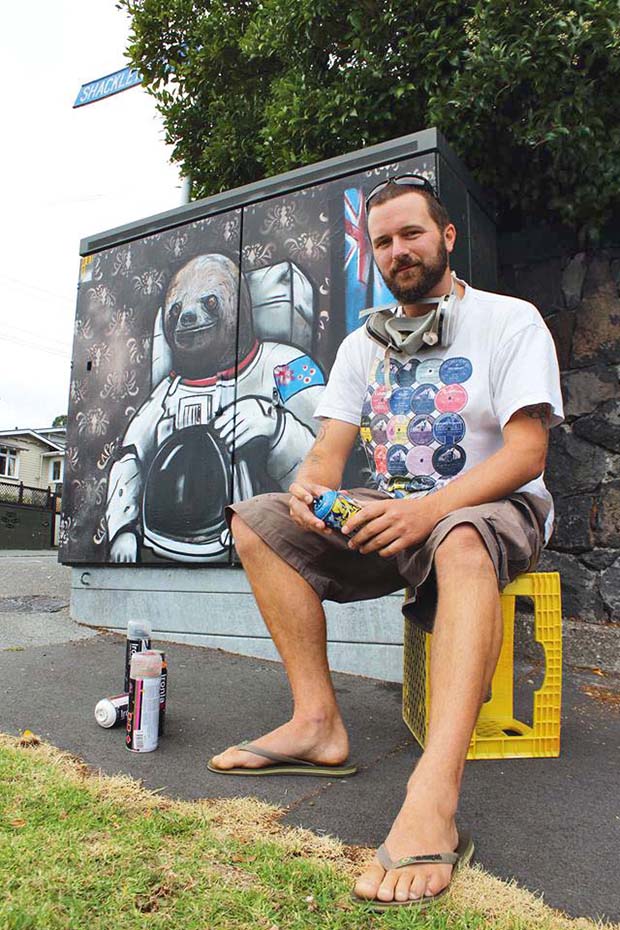Artist Paul Walsh on giving power to the people (through cats and spaceman sloths)

Ever wondered about the Chorus cable boxes around Auckland covered with curious creatures? Who created the sloth in a spacesuit, the jaguar in a party hat and the orangutan holding a “Don’t panic” sign?
Words: Jo Bates Photo: Danielle Street
“Paint whatever you want on our boxes, go wild,” the broadband fibre provider Chorus told self-taught Auckland-based artist Paul Walsh.
And so he did. He transformed 15 of their utility boxes in inner Auckland suburbs with internet memes to great acclaim, and not just local acclaim. The gallery of images he uploaded has been shared more than 15 million times.
“This subject matter hasn’t been taken seriously in the art world before. It amuses me that these slightly anthropomorphised animals, against a wallpaper-ish background, are zipping through the internet, which in turns zips through these Chorus utility boxes. At least, hopefully, when people are stuck in traffic, it cheers them up to see a painting of a cat wearing glasses,” he says.
Street art, and its proponents, is not unknown to Paul: “I’m familiar with some of the local taggers and a lot of them know that I came from a similar background of tagging and graffiti and stupid stuff when I was younger.”
This might be partly the reason behind the decline in the Chorus bill for cleaning graffiti and tagging off their boxes – especially the ones Paul has painted.
THE PEOPLE’S ARTIST
Initially Paul wasn’t paid for the utility-box art. However, he now is and this is gratifying for the anti-establishment artist whose public works are free for passers-by to contemplate. Paul’s other work ranges from private commissions to vast public murals, using a number of mediums. He is proudly DIY in his approach to selling his art.
“I don’t want to price myself out of the realm of normal people. I like the fact that most of the paintings I’ve sold have been to someone who’s never bought a piece of art before. I don’t want to make the jump to dealer galleries because they take 50 percent and increase your price by 50 percent and a lot of people just can’t afford it.”
PLYING THE TRADE
It has been a long slog, since selling his first painting aged 15, to gaining recognition and making art a fulltime career. His diverse CV includes a successful DJ stint and web design, but there have been times he’s had to beg, borrow and flog to realise his dream. “I’ve had about 30 various jobs while trying to make art my career. I was broke for a long time. I worked lots of crappy part-time jobs. I had a degree but not a job that enabled me to use it. I moved to the UK and couldn’t get work for eights months, so I was homeless and selling paintings on the street to get money for food. I’m now getting paid decent rates, almost like a plumber,” says Paul, whose attitude is surprisingly prosaic.
“What I’d like to see, in the way that society interacts with artists, is a return to how it was in Greco-Roman times when the artist was seen as a craftsman or tradie, to use modern terminology. If you are building a new house, you bring in the carpenter, the electrician, the artist. The emphasis also needs to be on the artist to treat their work professionally… there’s an assumption that if you enjoy doing the work you don’t need to get paid.”
FROM STRUGGLE STREET TO SUCCESS
Working from a shared studio on Karangahape Road that costs a little more than $40 a week in rent, the 38-year-old artist says his journey has been “a long road but I feel like I’m finally on the up. I had to get a lot more serious about the art, particularly now that my wife and I have two young kids to support. It’s tough making it a stable career financially, but we can do amazing things with canned goods!”
Just as he does amazing things with utility boxes and blank canvases.


